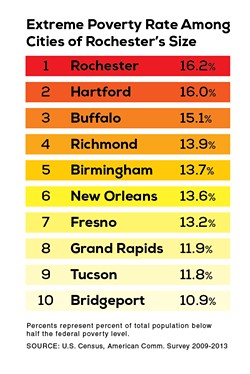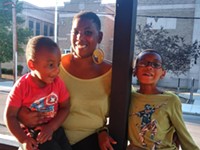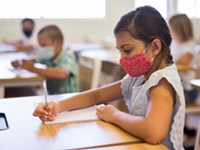Friday, January 9, 2015
Rochester's big growth area: poverty
Posted By Tim Louis Macaluso on Fri, Jan 9, 2015 at 5:00 PM
While unemployment is down both locally and nationally, the Dow is up, and the economy is clearly improving, Rochester is bucking the trends and sinking deeper into poverty. And the city’s children are suffering the most.
Rochester now has the distinction of being the only one of similar-sized cities to have more than 50 percent of its children living in poverty, according to an updated report from ACT Rochester and the Rochester Area Community Foundation.
Among those cities, Rochester also has the highest rate of extreme poverty – 16.2 percent – which is defined as people living below 50 percent of the federal poverty level, according to the report. That’s a family of four living on less than $12,000 annually.
Decades after President Lyndon Johnson declared war on poverty, Detroit; Cleveland and Dayton, Ohio; and Hartford, Connecticut are the only US cities with higher rates of childhood poverty than Rochester. It’s a strange, almost surreal evolution for a city that has more than once been cited as one of the country’s great boom towns. And it begs the question: Why?
“The biggest issue is the complexity of poverty and how hard it is to get out of poverty once you’re in it,” says Ann Johnson, program director for ACT Rochester. And, she says, there are different types of poverty – situational and generational — both with their own sets of challenges.
For low earners, a single event such as a health crisis or job loss can send them into poverty. Generational poverty is different, Johnson says.
“The lift to get out may even be heavier,” she says, because there are multiple factors. Among the biggest is the cost of housing, she says. Rochester has more than 50 percent of Monroe County’s rental properties — the main housing option for poor people. While federal guidelines for housing expense says it should not exceed 30 percent of an individual’s income, in Rochester whites spend 35 percent, Hispanics spend 48 percent, Asians spend 35 percent, and blacks spend 50 percent.
“If you’re making a low wage and half of your check goes to housing, what’s left for utilities, food, child care, and transportation?” Johnson says.
Education is another factor, she says.
“So few of our Rochester City School District children are reading at third-grade level by the time they’re in third grade,” Johnson says. “And the inability to read well at that point puts stress on your entire foundation of education because you’re reading to learn at that point.”
Johnson says that some issues are also difficult to quickly resolve, such as access to transportation and health care, and having an obstacle to employment like a criminal record.
“There’s no silver bullet,” Johnson says.
Rochester now has the distinction of being the only one of similar-sized cities to have more than 50 percent of its children living in poverty, according to an updated report from ACT Rochester and the Rochester Area Community Foundation.
Among those cities, Rochester also has the highest rate of extreme poverty – 16.2 percent – which is defined as people living below 50 percent of the federal poverty level, according to the report. That’s a family of four living on less than $12,000 annually.
Decades after President Lyndon Johnson declared war on poverty, Detroit; Cleveland and Dayton, Ohio; and Hartford, Connecticut are the only US cities with higher rates of childhood poverty than Rochester. It’s a strange, almost surreal evolution for a city that has more than once been cited as one of the country’s great boom towns. And it begs the question: Why?
“The biggest issue is the complexity of poverty and how hard it is to get out of poverty once you’re in it,” says Ann Johnson, program director for ACT Rochester. And, she says, there are different types of poverty – situational and generational — both with their own sets of challenges.
For low earners, a single event such as a health crisis or job loss can send them into poverty. Generational poverty is different, Johnson says.
“The lift to get out may even be heavier,” she says, because there are multiple factors. Among the biggest is the cost of housing, she says. Rochester has more than 50 percent of Monroe County’s rental properties — the main housing option for poor people. While federal guidelines for housing expense says it should not exceed 30 percent of an individual’s income, in Rochester whites spend 35 percent, Hispanics spend 48 percent, Asians spend 35 percent, and blacks spend 50 percent.
“If you’re making a low wage and half of your check goes to housing, what’s left for utilities, food, child care, and transportation?” Johnson says.
Education is another factor, she says.
“So few of our Rochester City School District children are reading at third-grade level by the time they’re in third grade,” Johnson says. “And the inability to read well at that point puts stress on your entire foundation of education because you’re reading to learn at that point.”
Johnson says that some issues are also difficult to quickly resolve, such as access to transportation and health care, and having an obstacle to employment like a criminal record.
“There’s no silver bullet,” Johnson says.
Speaking of...
Latest in News Blog
More by Tim Louis Macaluso
-

RCSD financial crisis builds
Sep 23, 2019 -

RCSD facing spending concerns
Sep 20, 2019 -

Education forum tomorrow night for downtown residents
Sep 17, 2019 - More »





